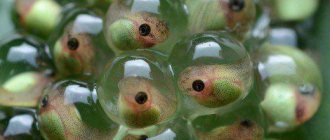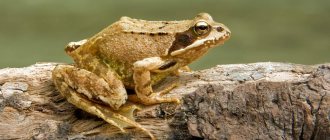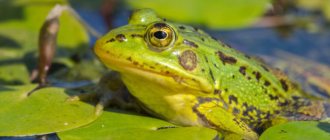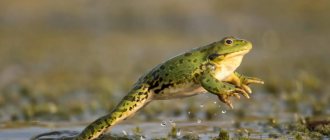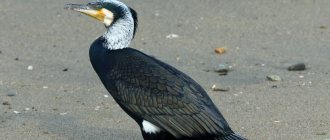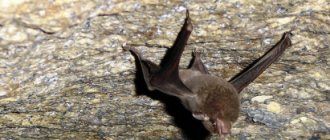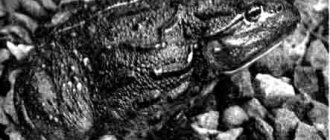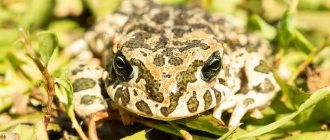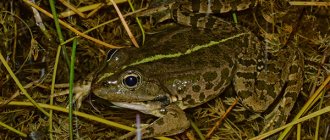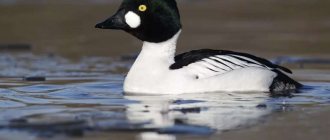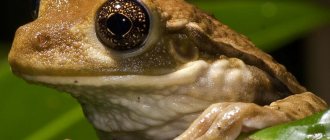While working in the garden, you can often stumble upon frogs unexpectedly jumping out of the green grass or important and clumsy toads barely crawling out. Many people are disgusted by these animals. Meanwhile, it should be remembered that there are benefits from frogs. They are tireless hunters of all kinds of small pests, bringing invaluable benefits.
The information in the article will allow you to take a closer look at the life activity of these animals, and perhaps many will even develop some sympathy for these interesting creatures.
Before we find out what a frog eats, let’s present its description.
Content
Why did the clawed frog become so popular?
Keeping these animals is not difficult. They are undemanding to the volume of the aquarium. A five-liter bottle is enough to keep one pair, but is it really possible to observe the habits of a fairly large animal in such a small space? Therefore, it is better to choose a container with a volume of at least 20 liters. Some species of clawed frogs can be quite large and reach 15 cm in length, which also needs to be taken into account. Please note that the white frog is an exclusively aquatic species. This means that the animal cannot go without water for a long time.
You can’t hold such a pet in your arms or let it go for a walk, but the clawed frog is perfect for keeping in an aquarium.
These amphibians are not thermophilic and do not require additional heating. The frog will feel comfortable at room temperature. Does not tolerate chlorinated water well.
You can’t just throw an animal into an aquarium, even if it’s an undemanding clawed frog. Keeping these animals is fraught with some difficulties. Frogs love to rummage in the soil, so it is better to choose coarse soil. Plants should be strong, with dense leaves and a strong root system. Many hobbyists plant plants in small ceramic pots. What protects them from destruction. Fragile plants with weak roots will be damaged, dug up and quickly die.
The clawed frog heavily pollutes water and releases a lot of organic matter. Therefore, you need to install a filter in the aquarium. In nature, these animals live in stagnant water, so filtration should not create a strong current.
The white frog, like the brown frog, breathes air, so aeration in the aquarium is not necessary. Clawed frogs are quite quick, so to avoid escaping, the aquarium must be covered with a cover glass. In order for fresh air to flow in sufficient quantities, it is necessary to leave a small gap.
Spreading
This family (true frogs) belongs to the order of tailless amphibians. The composition of the latter is numerous, including 32 genera and about 400 species. Most of them are inhabitants of the jungle (humid tropics).
The largest of the tailless amphibians is the goliath frog (3 kilograms), which lives on the coast of the Republic of Cameroon in Africa. Quite recently, the smallest frog was discovered in New Guinea - the size of a little fingernail.
Central Russia is mainly inhabited by species of the gray and common toad. They are widespread in Russia to Sakhalin, as well as throughout Europe and Africa (northwest).
Most of these amphibians have a modest, inconspicuous color, but some can have quite bright colors, especially for poisonous species that live mostly in the tropics.
Keeping aquarium frogs
Most aquarium frogs are unpretentious and original pets that do not require special conditions when kept at home.
Particular attention should be paid to the correct choice of aquarium, as well as compliance with the feeding regime
Requirements for water and aquarium
Frogs are not picky about water quality, and the main condition for proper water treatment is settling for three days, which allows minimizing the amount of chlorine. The level of hardness and acidity of water does not have a negative impact on the well-being of the amphibian.
The volume of the tank for a pair of pipa frogs should be approximately one hundred liters. It is advisable to provide good filtration and weak aeration, and fill the bottom with fine gravel as soil. Soft and slightly acidic water with a temperature in the range of 25-28°C is best suited for keeping pipa.
Toaded toads are kept in special aqua terrariums. A pair of adult individuals is allocated a tank with a volume of at least five liters. The daytime temperature should be 20-25°C, and at night the temperature can be lowered by about five degrees. The soil at the bottom can be sand or clean gravel. Be sure to install special shelters inside in the form of stones and plants.
Unpretentious clawed frogs do not require much space. To keep a pair of adult individuals, you need to prepare an aquarium with a volume of ten liters. The standard temperature day and night is 20-22°C. Soil, represented by pebbles or gravel, is poured into the bottom of the tank. It is imperative to provide shelter and vegetation in the aquarium, as well as a lattice lid, because this species often jumps out of the tank.
Caring for aquarium frogs
Aquarium frogs get cold quite easily, so when there are temperature changes in the air in the room, the amphibian’s home must be provided with high-quality heating. It is recommended to fill the tank two-thirds full with water, then cover it with a mesh or fairly heavy glass.
Be sure to leave a small gap between the aquarium wall and the “lid”. Water is replaced as it gets dirty, by updating 20% of the volume. Vegetation is best used if it is hard-leaved or grown in special pots.
Diet, what to feed
Amphibians are not picky when it comes to food, but in order to provide an aquarium frog with a complete diet at home, you should follow simple recommendations:
- The toad's main food is various invertebrates and insects;
- Pipa is fed with bloodworms, earthworms and small fish;
- Bloodworms, earthworms, crustaceans, shrimp, pieces of meat or fish are best suited for feeding the white frog;
- Tubifex, bloodworms and daphnia are used as food for Hymenochirus.
It is advisable to feed an adult no more than a couple of times a week. Eating more frequently often provokes obesity and problems with internal organs.
Compatible with aquarium fish
Not all aquarium frogs can be kept in the same tank with fish. The American pipa and fire-bellied toad, as well as the white frog, can only be kept with large and fairly active species of aquarium fish.
Hymenochiruses get along quite well with not very large fish, but maintaining such an aquarium biosystem in good condition will be much more difficult. Most frogs require standing water, while aquarium fish need good aeration.
What do frog tadpoles eat at home?
In order for a tadpole to develop into an adult, it requires quite a lot of care. After hatching, they begin to eat only on the 6th day. During this period, you can feed them baby formula or powdered milk.
After about two weeks you can start giving them well-steamed grass and insects
Finally, the tadpoles are fed bloodworms so that they develop a strong skeleton.
It is not advisable to feed them fruits, but if for some reason it is necessary to introduce them into the diet, then it is better to use dried apricots or dried apples. It is important not to overfeed the tadpoles, otherwise they may die.
Keeping the clawed frog
Claw frog photo
The optimal volume of an aquarium for keeping clawed frogs is 30 - 40 liters per individual. Frogs spend most of their time in the lower layer of water, so preference should be given to elongated aquariums. The aquarium must be tightly covered with a cover glass, since the clawed frog has very powerful jumps, it can accidentally jump out of the aquarium, and on land this type of frog is doomed to death due to very rapid drying out.
Optimal temperature for keeping clawed frogs. The temperature range in which the clawed frog can live is from 20 to 25 degrees Celsius. The optimal temperature is 21-23 degrees; if you intend to arrange a wintering period for the frog, keep in mind that the water temperature in this case should be 5-8 degrees; take care of the water cooling systems in the aquarium in advance.
Acidity of water. Optimal PH range: 6.5-7.5, remember that it is not so much the range itself that is important, but the stability of the indicator.
Filtration in an aquarium with a clawed frog. The clawed frog is far from being the cleanest animal and releases a large amount of organic matter into the water, while being very sensitive to the content of nitrogenous compounds in the water; it can quite easily become poisoned by its own waste, so it is necessary to ensure good filtration in the aquarium, 10 aquarium volumes per hour. It is best to use powerful mounted or canister external filters. Using an internal filter is also possible, but it should be taken into account that clawed frogs do not like strong currents, and installing various flow breakers can seriously reduce the performance of the filter. Another argument in favor of using external filters is the ability to place in it a large amount of substrate necessary for the normal life of a colony of nitrifying bacteria that will process ammonia, nitrites and nitrates.
Soil and decor in an aquarium with a clawed frog. The soil fraction in an aquarium with a clawed frog should be very large, since frogs very often swallow soil from the small fraction. That is why the area for the settlement of beneficial bacteria in such an aquarium will be extremely small. Some keepers keep frogs in an aquarium without any soil at all.
If you decide to use any decor in an aquarium with a clawed frog, keep the following rules in mind: the decor must be large enough so that the frog cannot swallow it, heavy so that it cannot move it, and not have sharp edges if the frog In a jump, he will run into a sharp corner of the scenery, resulting in a fatal injury. Try to place the decorations further away from each other so that the frog does not crash into them while jumping. If you plan to use different shelters where the frog can crawl, remember that the entrance to the shelter may be wide enough for an adult frog to enter without difficulty. Cases where a frog was able to climb into a shelter, but could not get out of there, are far from uncommon.
Plants in an aquarium with a clawed frog. Keeping plants in an aquarium with a clawed frog is problematic for the following reasons: firstly, the plants do not take root well in coarse soil, and secondly, do not forget about the claws and teeth with which the frog tears the plants. Anubias have a chance, since their leaves are hard and bitter, but this greatly depends on the character of the individual frog. If you still decide to decorate the aquarium with live plants, plant them in pots.
Lighting a clawed frog aquarium. If you keep an ordinary smooth gray clawed frog, it tolerates any light well, choose the one that is comfortable for you and the plants, if they are in the aquarium, however, remember, the lamps must be positioned so as to avoid heating the water.
If you keep an albino, keep in mind that bright light is contraindicated for any albinos (frogs, fish, mammals); bright light can lead to changes in the retina of albinos and subsequent blindness, which cannot be cured.
In setting up an aquarium for frogs, the bottomless range of REPTI-ZOO products in the attached catalog will help you; you will find everything you need for newts: soils, islands, plants, heating pads, lamps, etc. (the catalog is huge, it takes 2-5 seconds to load, we recommend downloading it to your computer).
Diet of frog tadpoles
The first thing you need to consider is that the tadpoles need to stay underwater until your legs develop. Under no circumstances should they leave the water early because they may die. Its development goes through several different stages:
First days : herbivorous phase . When the tadpoles start to move, after the first few days I am stuck in a certain place in the aquarium, it is normal for them to eat a lot of algae . This is due to the fact that tadpoles are initially primarily herbivores. So for the first few days, it's a good idea to fill the tank with algae and allow him plenty of time to swim and eat. You can also give them lettuce, spinach or potato skins . As with other foods, everything should be chopped finely so that it can be easily digested and digested...
Once the legs have grown: the omnivorous phase . Once your legs have grown, you should start changing your diet as he becomes an omnivore. Since it is quite difficult to provide a tadpole to a pet with food that it would eat in nature: garbage, phytoplankton, periphery, etc., this food should be replaced with other things such as
- Fish food
- Red larvae
- Mosquito larvae
- Rain
- Moscas
- Aphid
- Boiled vegetables
Again, remember that everything must be cut out . Additionally, all vegetables should be boiled because it can help prevent indigestion, gas and various stomach problems. Just like humans, if you don't give tadpoles a balanced diet, they will have digestive problems.
Keeping aquarium frogs with fish
Now let's figure out whether it is possible to house frogs with fish.
As for the clawed frog, knowing the peculiarities of its behavior, we can answer unequivocally - it has nothing to do with fish in an aquarium.
She will swallow everyone who fits into her mouth, destroy most of the plants, dig up the soil, raising turbidity, and move carefully installed decorations.
In addition, she does not like fresh water with a good current, and most fish will not like the swamp that is familiar to her.
The only advantage of living together between fish and clawed frogs is that the skin mucus of frogs contains antimicrobial substances that can have a healing effect on sick fish. But given the current level of development of aquarium pharmacology, this can hardly be considered a serious argument. If you really want to do without chemicals, it is much easier to place the sick fish in a small container where the frog had been for some time.
Some aquarists advise keeping xenopus fish together with labyrinth fish, since they thrive in old water and breathe atmospheric air. But why do this? A separate small aquarium with frogs will take up very little space, and everyone will be happy as a result.
With hymenochiruses it’s not so scary. It is believed that they get along well with calm, not too large, non-predatory fish. They will not ruin the beauty of the aquarium either. However, in a large aquarium, Hymenochirus spend a lot of time in hiding, so it is almost impossible to observe them, and it can be quite difficult to control the process of their feeding.
Where does a frog's tail go?
Once in the blood, the substance gives the frog energy to create new organs, accelerating the transformation process. In fact, the tail
does not disappear, it is absorbed into the butt, nourishing the entire body with its remains.
Interesting materials:
How to change units of measurement in Word? How to view guests on WhatsApp Plus? Like in world of tanks blitz? How to transfer mouse control in Zoom? How to cook bronze? How to return the default launcher? How to return qwerty keyboard? How to return the default theme to Xiaomi? How to return the standard launcher to Android? How to return to the old keyboard layout?
Growing conditions
It’s difficult to say that aquarium frogs are the cutest creatures. Fish are cleaner and less aggressive than amphibians. But lovers of wildlife, who are ready to organize mini-ecosystems at home, prefer to have frogs instead of silent fish (or together with them). Out of great love for zoology, you can join the ranks of the owners of such unusual pets and care for them.
Interestingly, the clawed frog, ready to become your pet, is the first vertebrate that has been cloned. And another interesting fact: about 100 years ago, the clawed frog was used as a pregnancy test. If you inject her with pregnant urine, she will begin spawning under the influence of hCG.
Because frogs are interesting zoological objects, many people do not view amphibians as living aquarium toys. They are serious about keeping amphibians, caring for them, and making observations. And they carefully study all available information in order to allow the underwater inhabitant to live a completely comfortable and happy aquarium life.
Requirements for an aquarium
If you are keeping a couple of large frogs, then the approximate volume of the aquarium should be about 100 liters. The tank needs good filtration and low aeration. The toaded toads will live in an aquaterrarium - a special device. A couple of adult toads should expect a tank of at least 5 liters.
For Shportsevs, 10-20 liters is enough for two. There must certainly be enough hiding places in the aquarium, because this species prefers reclusiveness to a “secular” lifestyle.
Water
The basis of proper preparation is to let the liquid settle for 3 days, this reduces the amount of chlorine in it. Amphibians are unpretentious to the level of acidity and water hardness. Experienced aquarists advise not to pour it out when changing the water in the tank. The water that has been settled and drained from the sediment is suitable for filling a fish tank. The water temperature is quite high - from 22 to 28°C for different types of amphibians.
Priming
Large pebbles will be required as soil for popular species of aquarium inhabitants. For American pipa, fine gravel will also be suitable. Fire-bellied toads like sand and clean gravel, while toaded toads prefer pebbles.
Plants
Plants, if present in the aquarium, can only be hard-leaved. They can only be planted in pots, otherwise the frogs will quickly start digging. It’s good if the plants form entire thickets in the water house, the frogs will like to hide behind them.
It should be noted that frogs, like all living beings, are susceptible to disease. Some diagnoses of aquarium amphibians are quite common.
- Nematode infection. Amphibians become gray, rough, and their skin peels off. They lose weight very quickly, and when scraping the skin, you can actually notice millimeter-sized worms.
- Fungal diseases. More often, the fungus affects injured areas of the skin, where a cotton-like coating is formed that can move throughout the body.
- Red paw. This is the name for a bacterial infection that causes red spots to appear on the frog’s legs and face.
- Dropsy. Another bacterial infection, in which the amphibian swells like a balloon, swells, and the body loses its usual contour.
Frogs are treated with products for tropical aquarium fish, selected according to the causative agent of the disease. If there are several frogs in the container (or they live with fish), the sick pet will have to be isolated. Obese frogs and pets living in uncomfortable conditions are more susceptible to diseases.
Frog hunt
More than half of the lake frog's diet is occupied by terrestrial insects, of which about 25% are flying forms. The frog is indiscriminate in food: it feeds on what is most available at the moment. Having examined the stomachs of 230 grass frogs, scientists counted 87 food components there, of which beetles are in first place. Then come Orthoptera, Hymenoptera, Diptera and others, including spiders, woodlice, bugs and mollusks.
The long sticky tongue is the main catching organ of the frog. Having creeped up, the amphibian forcefully throws out its tongue, which sticks to the victim and drags it into the throat. But it is impossible to see the process with the naked eye: the entire flight to the target and return with the prey takes hundredths of a second. You can only watch the frog hunt using slow motion.
It should be noted that not all amphibians use language, like a lasso. Some people prefer to rely on the speed of the throw. The frog (Rana dalmatina), which lives in Europe, hunts mainly flying insects, which it catches in a jump. This small amphibian is capable of flying more than a meter in height, and escapes from its pursuer in three-meter leaps.
Most frogs are fluent in the art of camouflage. They do not need to scour the grassy jungle, since the careless “game” itself goes to the catcher. The lake frog makes ambushes under the leaves of aquatic plants. Sometimes she comes across a very unusual trophy - a bird. As a rule, these are fledglings of small passerines that do not have very good control of their wings.
Young fish at an early age are a tasty prey for the lake frog. It can cause considerable damage to fish farms by eating valuable juveniles. The frog hides in shallow water and waits for a flock of fry to swim up to its very nose. The amphibian sharply opens its mouth - and several fish are drawn into it at once by the flow of water. Instead of the fry, tadpoles may swim up, even of her own species - the same fate awaits them. However, by picking up weak, sick and injured fish, the frog acts as an aquatic orderly.
Bats, lizards, young snakes, shrews and other small vertebrates were found in the stomachs of lake frogs. Often juvenile toads and frogs of other species were found there. Amphibians have powerful digestion - due to the lack of claws and fangs, they have to swallow victims whole, as snakes do.
Among tropical species there are frogs that specialize in toads (Rana aesopus) or crabs (Rana ridibunda). And Rana occipitalis chose such unsafe prey as tarantulas. But if these same frogs are moved to an area abundant in other food sources, then their previous preferences will be immediately forgotten.
The table clearly shows that most frogs can be called “animal eaters” - they feed on both vertebrates and invertebrates, without giving preference to any particular species. Most likely, insectivorous frogs do not hunt anything larger only because their growth does not allow it.
Plant remains are also present in the stomachs of frogs, but this does not indicate vegetarian inclinations: when a frog catches an insect, part of the leaf or flower on which the insect was sitting is glued to its tongue. The frog quickly swallows everything and, without wasting time, goes for a new portion. Her stomach is able to digest everything: hard chitin and plant fiber; even bones and feathers disappear there without a trace.
Description and types
There are 2 types of frogs that can be found in modern aquariums. Each of them has a characteristic appearance, behavior and environmental requirements.
Most often, hobbyists get a xenopus (clawed frog). There are two varieties of these amphibians on sale. One of them has white, yellow or slightly pink skin and red eyes and is an albino. This subspecies of clawed frogs was artificially bred in laboratory conditions for experiments. Another variety is a wild, gray-brown color with spots. This subspecies of amphibians is larger; there are no membranes on their feet. Clawed frogs grow up to 10−12 cm.
Another species is Hymenochirus (dwarf frog). It has slimmer, long legs and a pointed muzzle. The size of Hymenochirus is only 4 cm. Its color is gray, brown or olive with spots. In the aquarium, Hymenochirus are distinguished by their calm disposition and inactive behavior. They are harmless and prefer to hide somewhere near the bottom. Clawed frogs, on the contrary, move a lot, swim actively, can pester fish in an aquarium, sort through the soil and move pebbles in search of food.
How to care for aquarium frogs?
If you initially provided all the necessary conditions regarding volume, water temperature and equipment, the frogs in the aquarium will feel great. All you have to do is change the water on time, plant the plants, feed them, and turn on the lighting if necessary. By the way, it’s worth talking about feeding aquarium frogs in more detail.
What to feed aquarium frogs?
All types of aquarium frogs prefer live food. For larger spurs, these will be earthworms and mealworms, large bloodworms, crickets, tadpoles, and fry. You cannot feed them with tubifex. You can give them pieces of fish, meat (lean), liver, and shrimp with tweezers. The feeding frequency is 2 times a week. Clawed frogs have a well-developed sense of smell, so they eagerly rush to food immediately.
What aquarium Hymenochirus frogs eat is determined by their small size. They simply cannot swallow crickets and worms, so they need to be given small bloodworms, live daphnia, finely chopped meat and fish. At the same time, they literally need to slip food right under their noses. Alternatively, you can train them to feed in the same place and on a specific signal. For example, they should understand tapping with tweezers as an invitation “to the table.”
What do frogs eat in nature?
Toads have an excellent appetite. The main food for them are invertebrate animals: worms, insects, bedbugs, spiders, caterpillars, mollusks, etc. More than half (60%) of all insects eaten by the toad are agricultural pests. These animals also feed on slugs. Many gardeners observe unpleasant slugs on strawberries, which usually hide in the damp soil during the day, and in the evening come out to eat the soft, juicy fruits of sweet, ripe strawberries. It is very difficult to fight them. This is precisely where toads are excellent helpers.
The adult frog is a carnivore. The frog feeds on mosquitoes and other types of insects. For the lake fish fry are tasty prey. Due to this, considerable damage is caused to fish farms. Hiding in shallow water, the frog waits for a school of fry, and having waited for them, it sharply opens its mouth, into which a bunch of fish are drawn in by the flow of water. Tadpoles may also be in the mouths of the fry.
Plant remains are often present in the stomachs of frogs, because part of the leaves and flowers on which their prey sat sticks to their tongue. All this is quickly swallowed by the frog, after which it again goes for new food.
Reproduction and lifespan of the clawed frog
The breeding process of clawed frogs will require, at a minimum, the presence of two individuals of different sexes and a water temperature of 22 to 25 degrees. Accordingly, you will have to purchase older individuals; the difference between the sexes is noticeable from 7-8 months:
- the female is large, thick, seems loose, is shaped like a pear and is always silent;
- the male is small, very agile, with thin legs, slender and makes sounds similar to bird chirping.
The female lays about a hundred eggs at a time; if frogs are needed, this clutch must be removed, as otherwise. the female will eat at least half of what is set aside. Frogs should breed after one and a half or two years, when their decorative qualities are fully formed, which will allow choosing a combination of optimal producers.
Mating of clawed frogs during the breeding season
You should also not force the frog to lay eggs more than 3 times a year, as this will negatively affect the health of the lady frog and affect the quality of the offspring.
In addition to the water temperature, for successful fertilization of the clutch, darkness is needed, since the “boys” of spurs are not shy about carrying out the act itself in the light, but they are shy about fertilizing the eggs. Clawed frogs live for 15-16 years, with the exception of albino frogs, which do not reach 12.
However, diseases can shorten the lifespan of clawed frogs; generally, these amphibians begin to get sick in cold or too hot water, or they are poisoned by rotten leftover food. To avoid such troubles, the remaining food and dead fish must be removed immediately and the water temperature checked. And. Of course, clean the aquarium.
General information about toads and frogs: differences
Toads and frogs are tailless amphibians that live in water and on land. Even when leaving the water, these animals are very dependent on it. In addition to pulmonary respiration, they also have active skin respiration, which allows amphibians to stay under water for a longer time. But dry air and prolonged exposure to the sun have a detrimental effect on them.
What does a frog eat? You can find out more about this below in the article.
Frogs and toads are closely related. The difference between them is that frogs have smoother skin, long strong hind legs with well-developed membranes between the toes. All this helps frogs to jump well and swim quickly. And the toad has dry skin covered with “warts”, their legs are weak and short, allowing them to move only by waddling or in short jumps. The membranes between the toes are not developed, which is why they swim poorly and spend less time in the water (in fact, only during the breeding season).
It is difficult to determine by its structure and appearance what the frog eats, but it can be guessed. It has a flat back and head, and its eyes often protrude above the water surface like bubbles of liquid, without revealing the animal itself. The hind paws are strong, like a spring, and the front paws, designed like palms, are grasping. The frog's jaws are studded with sharp, small teeth facing inward. The wide mouth contains a sticky tongue. By comparing all of the above external signs, we can guess what the frog eats - mostly small aquatic inhabitants.
Types of aquarium frogs
There are currently two species of frogs kept in aquariums: the smooth clawed frog (Xenopus laevis), which has been bred in captivity for many years, and the dwarf frog (Hymenochirus boettgeri), which has become popular not so long ago. Adult frogs of these species vary greatly in size, appearance, behavior, and maintenance characteristics. Frogs in pet stores are often kept in the same aquarium and when sold they do not always focus on their species.
So, if aquarium frogs are white or pinkish, with red eyes, then, regardless of size, they are clawed frogs. The albino clawed frog was artificially bred at the Moscow Institute of Developmental Biology for laboratory experiments.
If a small frog is grayish, brownish or olive in color with dark spots, then to determine the species you should pay attention to the length and thickness of its limbs, the presence of membranes between the toes of the front paws and the pointedness of the muzzle. Wild clawed frogs are denser, have thicker legs with bandages like babies, a rounded muzzle, and no webbing on the toes.
Hymenochirus, on the contrary, has membranes, long and slender legs, and a pointed muzzle. The size of an adult Hymenochirus, as a rule, does not exceed 4 cm, while the clawed frog grows up to 10–12 cm.
Lifestyle
The amphibian is active in the evening and night. Stays awake during the day in case of cloudy weather or shady places. The rest of the time, frogs hide in stumps, under stones or in dense thickets. They prefer to stay alone, except during the spawning period.
Overwintering for an amphibian begins when the air temperature is +6⁰ C or lower. They survive the cold in large groups, which can include from ten to hundreds of individuals. They usually spend the winter in wetlands, muddy rivers or roadside ditches. The distance from the old and new habitat usually does not exceed one and a half kilometers. If living conditions in a previously selected area worsen, the group leaves it and selects another place.
During hibernation, the grass frog sits on its folded hind legs and covers its head with its front, previously turned palms up. The duration of wintering is most often 155-160 days.
How long do frogs live in nature and in captivity?
Under natural conditions, the method of skeletochronology is used to estimate the life expectancy of a frog. The use of this technology makes it possible to estimate individual growth rates, including the onset of puberty.
Studies on amphibians on the rhythm of annual growth have shown that most frogs live about 10 years in nature. However, the life cycle of some species can reach 30 years. Thus, gray toads are found to be twenty-six years old, and toads can live from 20 to 29 years. Tree frogs reach an average age of twenty-two years, while lake and grass frogs have a life expectancy of about eighteen years.
How long do frogs live at home? With proper care, which includes fluctuations in temperature and humidity, good nutrition and lack of stress, amphibians reach the age of 15 years. However, there is also a long-liver - a case of a frog has been recorded that lived thirty-two years.
Abundance and conservation status
The grass frog is a very common species, abundant in many places, although eggs and tadpoles often die when water bodies dry out.
In the south of the range in the forest-steppe zone it can be rare and live in small isolated areas; The disappearance of a number of populations is noted here.
In the northern part of its range , especially in the taiga zone, the grass frog is the most widespread species of amphibian.
In the central zone of the European part of the former USSR, it is inferior in number to the sharp-faced frog.
Overall the species is in fairly favorable condition. Found in many nature reserves.
Many factors cause the death of frogs:
- pollution of water bodies with harmful substances and household waste;
- heavy traffic;
- catching for laboratory experiments and for terrarium enthusiasts.
The destruction of forests and industrial pollution have led to the fact that in some places these frogs have completely disappeared.
It is not included in the Red Data Books of the former USSR and other republics. In Europe it is protected by the Berne Convention (Annex III).
Video
Frog: species
Tailless amphibians are divided into three types: frogs, toads and tree frogs.
Frogs are characterized by smooth, slightly lumpy skin, swimming membranes on the hind limbs and teeth located on the upper jaw. The most respectable representative of this species is the goliath frog, predominantly found in West Africa. Its length is up to 1 meter, and its weight is about 3 kg. Impressive sizes! Such a frog amazes the eye. What does such a large individual, capable of jumping up to 3 meters, eat? The Goliath frog feeds on its small cousins, spiders and scorpions, and can live up to 15 years. Her lack of a vocal resonator is compensated by her excellent hearing.
The smallest frogs found in Cuba range in size from 8.5 to 12 mm.
Habitat
Currently, the range of the grass meadow extends from the British Isles to the Urals and Western Siberia.
Habitat of the grass frog
The northern border of the range runs through Norway, Finland and the Kola Peninsula off the coast of the Barents Sea. Absent on the Mediterranean coast, Crimea, and the Caucasus.
Interesting fact. The grass frog is the only species of frog native to Ireland and the only amphibian found off the North Cape, the northernmost point of Europe.
In 2005, the grass frog was introduced in the south of Kamchatka, where the first Kamchatka population was formed, which independently spreads and sustains itself.
There are from 4 to 6 subspecies of grass frogs.
Why do frogs grow extra legs?
The absence of one paw from the symbol of wealth can be explained in any way (according to legend, the fourth was taken away by Buddha for sins), but individuals with extra paws have long puzzled scientists, and they have sinned on chemical waste. It turned out that amphibians become victims of chemicals that did not get into water bodies, the Ribeiroia parasites, which have a complex life cycle that begins in snails. As they grow up, they look for a new host, which becomes a fish or tadpole. And since the tadpole is in the process of growing legs, the process of reproduction of new molecules is disrupted and spreads to other parts of the body, causing the growth of new limbs. The maximum number of legs observed on a frog by humans was 10 on each side.
What does a frog tadpole look like?
Tadpoles are the first stage in the life cycle of a frog or toad . Like many other amphibians, frogs suffer from metamorphosis; they are born as small larvae and then become adult frogs.
The larva is rounded off as soon as it leaves the egg. At this point, only the head can be discerned, and the tail is not yet developed. As metamorphosis progresses, it begins to develop a tail and takes on the shape of a fish. Your body will slowly begin to change until it becomes a tadpole.
Frog tadpoles can remain in water for up to three months, breathing through the gills they are born with. Tadpoles regularly stick to an object in the aquarium and remain motionless for the first few days. They are going to start swimming and eating later . This way, they can eat foods they previously consumed for the first few days before starting to eat the foods listed below...
This is interesting: Life expectancy of popular types of hamsters at home?
Nutrition
The clawed frog is omnivorous. At home, her diet should be varied and balanced. These are dry, live and frozen types of food.
For example:
- Mealworms and earthworms;
- Bloodworm, Artemia, Gammarus;
- Shrimp meat and fish fillet;
- Feeding insects;
- Special fortified flakes and granules.
As a treat, you can sometimes give frogs pieces of beef heart, but not often. It is too high in calories for them and frequent eating can cause blockage of blood vessels. Frogs are prone to gluttony, so it is recommended to feed adults once every two to three days.
The clawed frog is quite hardy and very poor living conditions can provoke diseases. But with proper care, these interesting amphibians can live 10-15 years.
What to feed your pet frog
Now in pet stores you can find quite a variety of food for frogs. They contain all the necessary components for proper nutrition.
Under no circumstances should you overfeed your pets, as this can lead to their death. How often to feed frogs depends on their age, but basically:
- little frogs are fed every day
- adults once every three days
In addition to store-bought food, they offer bloodworms, shrimp, live small fish, and meat.
It is also necessary to introduce vitamins and minerals into the diet. Such supplements can also be purchased at a pet store.
The water needs to be changed regularly as frogs bathe and drink through their skin. And the terrarium itself must be cleaned every two days.
Description of species
In fact, there are only two types of frogs that can act as pets.
- Xenopus. It has an alternative name "spur frog".
- Hymenochirus, and if we call it more simply, then “dwarf frog”.
Both of these species can be bred very easily subject to certain conditions.
It is very important to be able to correctly distinguish between such representatives
Most often you will find these creatures planted together in one large aquarium, but distinguishing them is quite easy.
- An albino, or literally a white frog with red eyes, is a Xenopus. This species was bred by Russian scientists specifically for research in laboratories.
- If you notice gray, brown spotted or even olive-colored skin, rest assured that this is a dwarf frog.
One of the main differences between the dwarf frog is its size, which does not exceed 4 centimeters. In the case of an albino ornamental frog, its size can even reach 12 centimeters, and this one will most likely have webbed feet. That is why distinguishing the type of pet you need from another popular species will not be a difficult task.
Varieties of frogs
There are more than 500 species of frogs in the modern world. To simplify perception, representatives of amphibians were conventionally divided into the following subfamilies:
- toad-like;
- scythe-dactyls;
- real;
- African forest;
- dwarf;
- Discopals.
The following are considered the most amazing and unusual frogs in the world:
- transparent (glass) - individuals grow up to only 2 cm, have colorless skin through which all internal organs are visible;
- Cocoy poison frogs are miniature amphibians that produce a strong toxic venom in their skin that is superior to the most dangerous snakes in the world;
- hairy - unusual amphibians in which hair grows on the back and serves as a kind of respiratory organs;
- Goliath frogs are one of the largest tailless frogs, growing up to 40 cm and weighing up to 3.5 kg;
- pointed-nosed arboreal - have an unusual nose;
- bullfrogs are large individuals that produce a deafening croaking sound;
- flying frogs - small amphibians famous for their long jumps; they are capable of jumping up to 12 meters.
How often should you feed your tadpole?
Frog tadpoles must eat two small meals per day , although this frequency may vary depending on the type of frog. Additionally, you should remove any unused food from the tank in the same manner as you would with any other fish, and avoid pouring too much food in to prevent contamination of the tank.
If you enjoyed this article, you may be interested in the world's largest insects and examples of vertebrates and invertebrates...
This is interesting: What is the life expectancy of koalas?
Description of the sharp-faced frog (Rana arvalis)
- a very numerous species of our fauna, reaches a length of 78 mm. The back is brown or grayish with dark spots, the belly is white or yellowish, usually without spots. The throat is whitish, often with a marbled pattern. The sharp-faced frog spends all its time, including wintering, on land. Only for the breeding season does it move into a body of water. It feeds on terrestrial insects and invertebrates.
Spawning in the sharp-faced frog occurs in a very short time. Males spend only 20-25 days in reservoirs. The females arrive later than them and leave earlier, immediately after laying their eggs. One female lays 500-2750 eggs.
At low temperatures, sometimes even when a crust of ice forms above the masonry, the development of eggs continues for 8-10 days. The development of larvae takes on average 60-65 days, and in the tundra zone no more than 45-55 days.
Reproduction
The frog becomes sexually mature at three years. The mating process begins a week after wintering. To breed, frogs use shallow reservoirs with standing or running water, which may include lakes and puddles. A large amount of vegetation is required. The male comes to the pond before the female and calls her with so-called mating songs. Spawning lasts no more than a week. Before breeding, formations in the form of calluses appear on the male’s body, with which he holds his partner during fertilization.
The number of eggs and their size depends on the age and weight of the female. So, a three-year-old frog will lay about 900 eggs, and a six-year-old frog will lay approximately 3,600 eggs. The amphibian's clutch is a cluster of oval or round translucent shells. The female is the first to leave the spawning site.
The timing of the appearance of tadpoles directly depends on the air temperature. In cold areas, metamorphosis occurs after 20-60 days, and in warm places - after 90 days. This stage of development is characterized by a high level of death of young of the year. The number of surviving tadpoles is usually about 4% of the number of eggs originally laid.
Varieties
One of the most popular domestic species is the clawed frog, and it is the albinos (light with a pink tint) that become the inhabitants of aquariums in most cases. These are unpretentious amphibians, although they may seem like gourmets when it comes to food. Their body rarely grows more than 8 cm in length.
One individual needs 10 liters of water for its conditionally comfortable existence. The water temperature should be around 18–22°C. To equip a house for such a resident, you need a filter: without it, it will not be possible to cope with the volume of dirt produced by the frog. It is imperative to close the aquarium with a lid or glass with a gap. If you leave the “door” to the tank open, then you will then look for your Zelenka or Nikanor throughout the house.
When it comes to food, the white clawed frog prefers medium-sized bloodworms, daphnia, and small earthworms. The frog will not refuse a piece of lean meat. The main thing is not to overfeed your pets: these are voracious creatures, they do not follow diets, but they are at risk of obesity. An adult frog needs to be fed twice a week, but growing amphibians eat more often - 4-5 times a week. It is interesting that aquarium inhabitants hold food with their paws, quickly finger them, and push the tasty morsel towards their mouths.
Among the disadvantages of the clawed frog, one can note attempts on small fish. Neons or guppies will definitely become prey for an amphibian if you decide to make them neighbors. And clawed frogs are real dirty: they crap and also dig up the soil in a destructive manner. Plants are also pulled out and broken.
Among amphibians there are several popular species.
Hymenochirus. Miniature frogs grow on average up to 4 cm. These are slimmer frogs than claw frogs: they have thin legs, a less rounded body, and a pointed muzzle. They can live comfortably even in a 5-liter jar. The animals are thermophilic and do not tolerate frequent changes of water.
They have difficulty getting used to stationary food, because they are predators by nature. They also like to dig up the soil and raise all the rubbish to the surface of the water; these amphibians cannot be called neat.
Real amateur zoologists will want to have baby frogs at home in order to study them (and not just know their names), keep observation diaries, and take care of them.
Habitat
The family of true frogs (Ranidae) is part of the order of tailless amphibians. It is numerous: 32 genera and more than 400 species, the vast majority of which are inhabitants of tropical rainforests. The largest of the tailless amphibians, the three-kilogram goliath frog (Rana goliaph), lives in Africa, on the coast of the Republic of Cameroon. The smallest (pictured below) - recently discovered in New Guinea Paedophryne amauensis - fits on the nail of the little finger. Most frogs have protective colors, but the outfit can be very bright, especially in poisonous tropical species.
The smallest frog in the world
All amphibians are tightly attached to water, since drying out their skin means death for them. They breathe not so much through their lungs as through their skin, and their larvae, tadpoles, have gills. The warm and humid atmosphere allows them to go far from their native body of water and return there only during the mating season. In our latitudes, the so-called brown frogs act in a similar way: grass frogs, Siberian frogs, sharp-faced frogs and others.
Winter suspended animation
Temperate water bodies have become home to several species of frogs. The largest of them, the lake frog (Rana ridibunda), reaches 17 cm in length. A special feature of our frogs is their ability to hibernate. They spend more than five months a year in a daze under stones and snags, sitting in rotten stumps or buried in the silt at the bottom of lakes. Frogs do not use pulmonary respiration during hibernation, absorbing oxygen through the entire surface of the skin. But during the thaw, the amphibian “thaws out” and can even swallow some insect that has settled down to spend the winter nearby.
And finally, some interesting facts about clawed frogs:
- the clawed frog was the first vertebrate to be cloned;
- at the beginning of the twentieth century, clawed frogs were used to diagnose short-term pregnancy: if a frog is injected with the urine of a pregnant woman, under the influence of human chorionic gonadotropin it begins to spawn;
- The clawed frog does not have a tongue, therefore, when eating prey, it helps itself with its front paws, and it cannot bend its fingers, it holds them outstretched, as if it were eating with Chinese chopsticks;
- When clawed frogs accidentally entered the waters of the tropical part of the United States, they destroyed the native frog species there, so keeping clawed frogs is prohibited in some states and limited in others.
Fortunately, in our country keeping frogs is allowed, so everyone can have these undemanding funny animals at home, observe and care for them, receiving a lot of positive emotions and acquiring skills in keeping an aquarium. The latter will definitely come in handy in the future, because usually everything just begins with frogs.
Types of frogs
To date, experts have identified more than 550 species of animals representing the frog family. It should be noted that this family includes several subfamilies, represented by African forest frogs, disk-toed frogs and toad frogs, dwarf frogs and true frogs, including corymb-toed frogs.
Some species are very popular among those who like to keep rare animals at home, and therefore are kept as exotic pets.
The most interesting species of frogs include:
- Dominican tree frog.
- Australian tree frog.
- Some tree and poison frogs.
- Smooth clawed frog (aibolite frog).
- Red-eyed tree frog.
- Lake frog.
- Pointy-faced frog.
- Garlic frog.
The transparent or glass frog, the cocoy poison frog, the hairy and flying frog, the bullfrog, the clown frog, and the sharp-nosed tree frog are considered the most unusual species.
The most unusual frogs and toads. top 10
Watch this video on YouTube
Habitat
The habitat of the family is represented quite widely, so frogs can be found without problems on almost all continents, regardless of the climate zone. At the same time, most species prefer to inhabit the tropics, giving preference to fresh water bodies.
The True Frog family is widespread in the natural environment, although they cannot be found within South America, southern Australia, or New Zealand. On the territory of our country, the grass frog and the pond frog are mainly found.
The habitat of some species is associated with certain natural factors that limit the distribution of the species. Such factors include the presence of large rivers, the presence of mountain ranges or deserts, etc. This should also include barriers of artificial origin, in the form of canals, highways, etc.
In tropical conditions, all conditions are created for a greater diversity of species, compared to conditions in temperate and cold latitudes. And, nevertheless, some varieties are found even in polar conditions, as well as in bodies of salt water.
What do frogs eat
Frogs are considered predatory animals because they feed on animal food, represented by various insects. These amphibians eat large quantities of annoying insects such as mosquitoes. In addition, their diet includes various types of butterflies and small invertebrates. Sufficiently large subspecies can eat fairly large objects of animal origin, including their small relatives.
Frogs hunt by actively using their long and sticky tongue, and they have no problem catching insects in flight. Among the huge variety of species, there are omnivorous representatives of the family, which, along with animal food, consume berries and fruits.
Reproduction and offspring
Animals that live in tropical conditions reproduce during the rainy season, while those species that live in temperate latitudes reproduce with the arrival of spring, after emerging from hibernation. Before the breeding season, animals form numerous groups, with males preferring to occupy all the hills. This is necessary so that females can hear them at a considerable distance.
Males climb onto the backs of females and fertilize the eggs that the females lay. In this case, the caviar is bunched into dense formations, round in shape. Some species living in South Africa secrete a copious, foaming liquid that envelops all the eggs, forming a kind of nest. After some time, the foaming secretion hardens, after which the process of incubation of eggs occurs, followed by the appearance of offspring.
The number of eggs depends on the species and can range from several dozen pieces to several tens of thousands of pieces. Incubation periods depend on natural conditions and can range from 3 to 10 days. After birth, the offspring begin to develop rapidly, turning first into tadpoles and then into small frogs. This period can last from 40 to 120 days, depending on the variety.
Habitats of grass frogs
This amphibian is distributed throughout Europe, with the exception of the Iberian Peninsula. It is found throughout Scandinavia and extends here further north than any other amphibian. In the European part of Russia in the north it reaches the shores of the White Sea. The eastern border of the range extends to the lower reaches of the Irtysh, in the south - to the areas of the middle reaches of the Volga.
The amphibian inhabits almost all biotypes, but most often gives preference to coniferous, deciduous and mixed forests. At the border of its range, it is found even in the tundra and steppes. She also lives in cultivated areas - fields, vegetable gardens, gardens and parks. The mountains rise up to 3000 meters above sea level.
Like other amphibians, the grass frog tries to avoid salty bodies of water and is not able to live even a day in water whose salinity reaches up to 0.07%.
